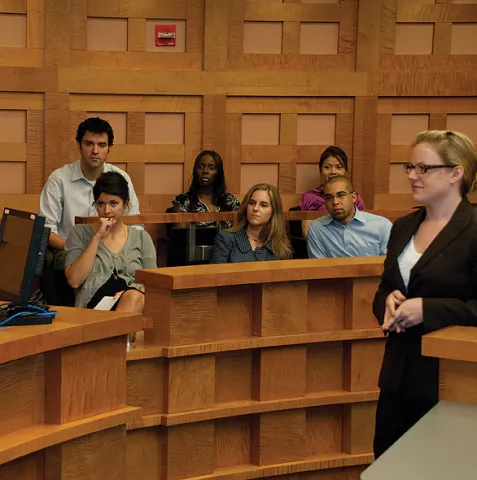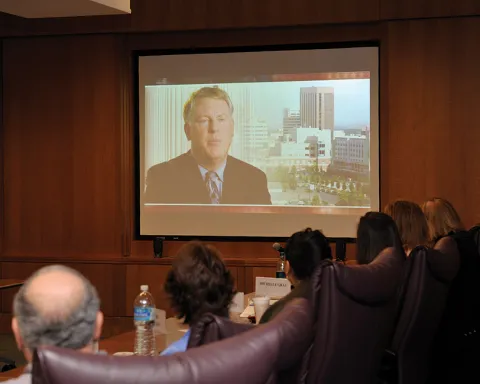
Growing digital media services are expanding the reach of the Judiciary’s public web communications.
Outreach
Civics Education Features Naturalization Ceremonies
To mark Constitution and Citizenship Day on September 17, AO staff produced a video slide show for the web highlighting naturalization ceremonies presided over by federal judges across the nation. The presentation heightens public awareness of this important federal court responsibility. Titled “The American Mosaic,” the piece features naturalized citizens, both well known and unknown, being sworn in as new citizens in different venues, including a Detroit Tigers baseball game. The video, which can be used at naturalization ceremonies and student programs, is available on the educational resources pages of the federal courts’ website at http://www.uscourts.gov/outreach/index.html.
Realistic Jury Experiences Prepare Future Jurors
In 2009, court outreach programs advanced the objective established in 1999 to motivate young people to serve on juries willingly when called. As it does every year, the U.S. District Court for the District of Columbia tested a variation on the annual Open Doors to Federal Courts jury experience with high school students visiting Washington, D.C. from across the nation. Working with judges, assistant U.S. attorneys, and federal public defenders, students at the D.C. courthouse were selected for juries, and then compared their in-court experience with media portrayals of the process. Like every courtroom program, this one was made available to all federal courts in an effort to reach thousands of high school students and their teachers with jury trial simulations on issues relevant to teens.
Video Communications

The AO created several webcasts during fiscal year 2009, as an effective way to inform and train court staff who need to remain at the office.
AO staff completed nearly 80 video products in FY 2009 covering a variety of news and educational topics for Judiciary employees, the public, and Congress. Most of these products were released as “streaming” programs for desktop viewing via the Judiciary’s public website, uscourts.gov, or the Judiciary’s intranet. Others were broadcast on the closed-circuit satellite network, distributed in DVD packages, or produced as live webcasts for targeted Judiciary audiences.
Designed for the general public and released in Spanish and Creole language versions as well as in English, the “Bankruptcy Basics” videos were played more than 5,000 times per week on uscourts.gov. The series explains the different types of bankruptcy available to citizens, and procedures for filing. Developed with the FJC, it is based on a public service program produced by the Florida Bar Association and other legal organizations.
A recruitment series introducing job hunters to the variety of employment in the federal Judiciary generated nearly 8,000 plays in the six months after its debut on uscourts.gov. To maximize court participation in certain meetings and training conferences, and contain travel costs, the Judiciary also produced six live webcasts during FY 2009, on topics ranging from human resource and financial management, to court interpreter training.
Media Relations and News
The Office of Public Affairs serves as the central point of contact for public information about the nation’s federal courts and as the chief liaison between the Judiciary and the news media. Its staff responded to several hundred queries from reporters nationwide during FY 2009. Some of those queries were follow-ups to information posted on the Newsroom page of the federal Judiciary’s external website, uscourts.gov. And as it has in the past several years, the Public Affairs staff hosted the Paul Miller Fellows, a group of Washington-based regional journalists, for a discussion of federal court coverage. They also continued to participate in the Judges-Journalists programs, which for the past decade have been cosponsored by the Judicial Branch Committee and the First Amendment Center.
The Third Branch is the Judiciary’s newsletter of record, reaching 12,000 legislators, members of the Judiciary, attorneys, academics, and interested citizens each month. Primarily a print publication, the newsletter is experiencing growth in online readers, and that number is expected to grow during 2010 when a new design is incorporated into the public website.
The “New” Internet for Judiciary Communications
Uscourts.gov is the Judiciary’s external website and its primary tool for reaching the media and the public at large. A redesigned and restructured site, when launched in early 2010, will offer an enhanced user experience, including the latest multimedia and Web 2.0 features to those interested in learning more about the federal Judiciary. It is projected that uscourts.gov will register more than 34 million page views in 2009. Several new web tools were added during 2009, and more are under development for 2010.
Email Delivery Service
Five thousand users subscribe to uscourts.gov email updates for free alerts about news releases, newsroom updates, new publications, emergency notifications, and significant content updates.
Multimedia: Video, Podcasts, Photos, YouTube Channel
News videos have been available on uscourts.gov for several years. Recently, two informational video series, Bankruptcy Basics and Working for the Federal Judiciary, were added and have been viewed widely. Many federal courts link to these videos from their sites.
Audio podcasts of federal rules hearings were added to uscourts.gov during fiscal year 2009, so that interested listeners can download the files and listen at their convenience. Producing and posting the podcasts to uscourts.gov expends minimal resources and reaches an important target audience. Multimedia use will expand on the new uscourts.gov with areas for video and podcasts as well as photos and a link to the Judiciary’s YouTube channel that is under development.
New Web Tools Will Expand Reach
The Judiciary is exploring development of new web tools to educate the public as other government agencies are doing. Uscourts.gov will continue to expand use of RSS or Really Simple Syndication. RSS is a web format used to distribute content updates to blogs, news, publications, audio, and video. Plans to share dynamic content with court and other websites will expand with widgets, web-based tools designed for content sharing.
In addition, the new public website will feature a bookmark tool to encourage visitors to return to the site, and to email content or post it to another site including De.icio.us, Digg, or other networking sites. In the coming year, uscourts.gov users will be able to view and use content from the website on mobile devices. Finally, translation of some uscourts.gov content into additional languages is being explored; a Spanish version of Bankruptcy Basics will be posted in early 2010.
Annual Report 2009
- Annual Report 2009
- Legislative Activity
- Direct Impact On The Public
- Judges Programs
- Facilities, Security, and Emergency Planning
- Business Improvements, Studies, and Activities
- Key Studies and Activities
- Human Resources
- Technology
- Probation and Pretrial Services
- Defender Services
- Communications
- In Profile
- A Strategic Direction For The Administrative Office of the United States Courts, Fiscal Years 2009–2013
